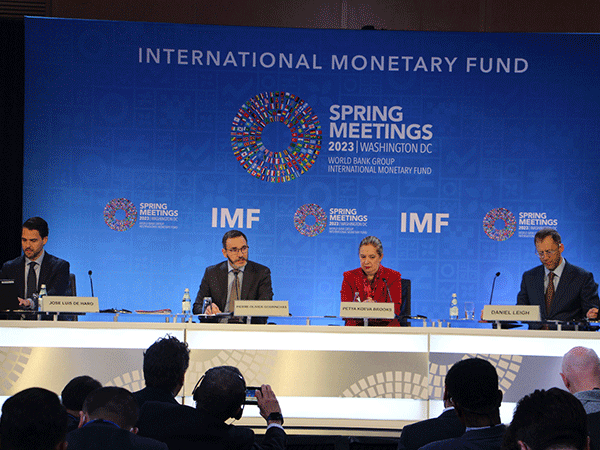 |
| Experts clarify journalists about the projected growth in different regions at the press conference on the World Economic Outlook in Washington DC. |
Lao economy projected to grow at 4 percent this year: IMF
WASHINGTON DC -- The International Monetary Fund (IMF) on Tuesday projected that Laos will see economic growth of 4 percent this year and next year despite global economic uncertainty.
In its April World Economic Outlook, the IMF stated that the lifting of travel restrictions and the reopening of China (a key trading partner of Laos) will contribute to the regional economic growth including Laos.
"The reopening and growth of its economy will likely generate positive spillovers, with even greater spillovers for countries with stronger trade links and reliance on Chinese tourism," the report stated.
The IMF projected that China's economy will grow by 5.2 percent in 2023 and 4.5 percent in 2024 while global economy is forecast to see slower growth to 2.8 percent in 2023 before rising modestly to 3 percent next year.
The IMF’s economic projection is similar to that projected by the ADB in its recent flagship publication “Asian Development Outlook” for April 2023, projecting gross domestic product (GDP) growth in Laos this year and next at 4 percent, rising from the 2.5 percent reported by ADB last year.
The ADB stated that the recovery in services and private sector investments is expected to drive economic growth in Laos this year and next year as pandemic restrictions are eased throughout the region.
According to the IMF, while the global economy is expected to see slower growth, the economic growth prospects for emerging markets and developing Asia are on average stronger than for advanced economies.
On average, growth is expected to be 3.9 percent in 2023 and to rise to 4.2 percent in 2024.
The projected growth for Thailand (Laos’ main trading partner) is 3.4 percent this year and 3.6 percent next year; Vietnam (5.8 percent for 2023 and 6.9 percent for 2024); Cambodia (5.8 percent in 2023 and 6.2 percent in 2024); Indonesia (5 percent in 2023 and 5.1 percent in 2024); Malaysia (4.5 percent for 2023 and 2024); and Myanmar (2.6 percent for this year and next year).
One of the main challenges for Laos in the coming months is to curb inflation, as the current rising cost of goods and services are creating extra hardship for people already struggling to rise above poverty.
The IMF forecasts that increases in consumer prices in Laos will average at 15.1 percent this year, which is the highest rate projected for emerging and developing Asian nations.
Global inflation has declined as central banks have raised interest rates, reflected in a sharp reversal in energy and food prices.
But core inflation, excluding the volatile energy and food components, has not yet peaked in many countries.
By Somsack Pongkhao
(Latest Update April 15, 2023)
|